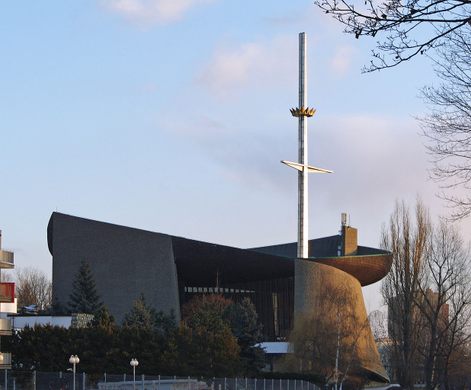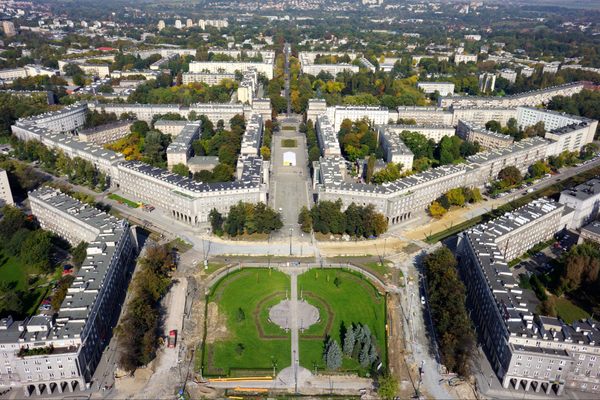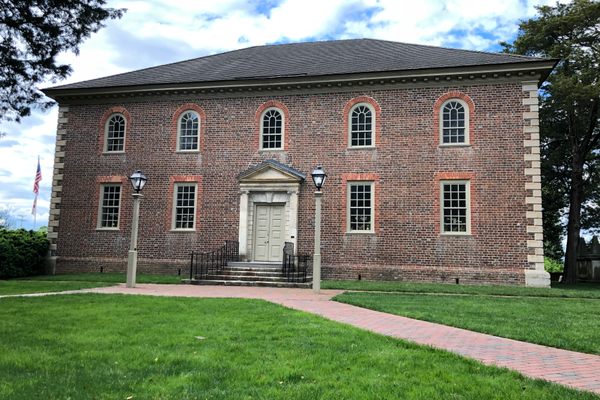Lord's Ark
In the midst of a living monument to Soviet social engineering, Polish Catholics built this church by hand.
In 1947, Poland lay in ruin, ravaged by the destruction of World War II. In the process of rebuilding the country, the Soviet Union saw an opportunity to create what it envisioned as the magnificent proletarian city of the future.
Built just to the east of Kraków, the Polish city of Nowa Huta was supposed to be the Communist answer to its decadent bourgeois neighbor. In its carefully planned layout — including streets lined with trees to help absorb the impact of a NATO nuclear attack, a “fortress in disguise” design that supported defensive urban guerilla warfare, and a truly massive steelworks that gave the city its name (“New Steel Mill”) — Nowa Huta was intended to create, from scratch, a workers’ paradise on an epic scale. Fully funded by the USSR, it was one of only two fully-planned Socialist Realist cities ever constructed (the other being Magnitogorsk, Russia), and is considered one of the “best” examples of deliberate social engineering in the world.
One thing that was never part of the plan was a church, since churches didn’t really fit into the whole atheistic-revolutionary-society-of-the-future vibe the Communists were going for. The actual residents of Nowa Huta, however, had other ideas, and started lobbying for permission to build a church shortly after they moved in. Permission was granted in 1956, but then suddenly rescinded in 1960, leading to protests that were met with violence from the police and militia. Local sentiment remained steadfast, however, and permission was finally secured again in 1967.
With one interesting twist.
While Communist authorities would allow a church to be built, they would not make any equipment or materials available for the building — which, in a centrally planned, state-run economy, posed a bit of a problem. Thus, the Lord’s Ark church was built by hand, with local residents mixing their own cement, making their own bricks, and gathering the roughly two million stones that comprise the church’s distinctive facade. Designed to look like Noah’s Ark resting on Mount Ararat after the flood had finally receded (SYMBOLISM ALERT), the cornerstone for Lord’s Ark was laid in 1969 and the church was consecrated in 1977 (officially as Church of our Lady the Queen of Poland), both by Cardinal Karol Wojtyła, who would go on to become Pope John Paul II in 1978.
Somewhat ironically, Nowa Huta went on to be a major stronghold for the anti-communist Solidarity movement during the political conflicts of the 1980s, and Lord’s Ark played its part, providing shelter from militia violence and celebrating monthly Masses for the Fatherland through the Martial Law period from 1981 to 1983.
Today, Lord’s Ark remains one of the most recognizable and important landmarks in Nowa Huta, and its unique design — both inside and out — give it the sci-fi feel of a lone Catholic spaceship adrift in an inhospitable Orwellian system. Driving this futuristic theme home, the tabernacle even contains a moon rock brought back by Apollo 11. Other furnishings of note include: a stone from the tomb of St. Peter; a hardcore industrial pietà; a crucified Jesus about to fly to heaven; and a statue called Our Lady the Armoured, which is made entirely of WWII shrapnel removed from Polish soldiers at the Battle of Monte Cassino, in which Rome was liberated from Axis control.


















Follow us on Twitter to get the latest on the world's hidden wonders.
Like us on Facebook to get the latest on the world's hidden wonders.
Follow us on Twitter Like us on Facebook